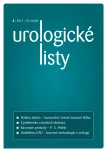-
Medical journals
- Career
Readmission and complication rates in patients undergoing PCNL, stratified by co-morbid factors
Authors: N. Ginzburg; A. Ovadiah; D. M. Hoenig
Published in: Urol List 2012; 10(3): 44-47
Overview
Purpose:
To examine patient characteristics and outcomes analysis following Percutaneous Nephrostolithotomy (PCNL), including complication rates, ER visits, and readmission rates stratified by stone factors and medical co-morbidity.Materials:
Charts of 185 patients undergoing PCNL from 2004 to 2009 were retrospectively reviewed. Multiple patient characteristics were examined, including Body Mass Index (BMI), co-morbid medical illnesses (diabetes, coronary artery disease), preoperative urinary tract infection, stone burden, sex, age, length of surgery, number of access sites. These characteristics were correlated with outcome measures with respect to complication rates (transfusion, ICU stay, sepsis), length of hospital stay, emergency room visits, and readmission rates.Results:
Univariate and multivariate regression analyses were performed. Statistically significant correlations were found in diabetic patients with respect to higher readmission rates (p ≤ 0.001), emergency room visits, and complication rates following PCNL (p = 0.039). Additionally, a significant correlation between BMI and readmission rate was also found (p = 0.039).Conclusion:
In contrast to prior studies, our retrospective review of 185 patients in an urban hospital setting demonstrates a correlation between complication rates after PCNL, with higher rates of complications, readmission, and emergency room visits in diabetic patients, and those with elevated BMI. These patients should be appropriated counseled preoperatively to reflect these higher complication rates which appear attributable to these underlying conditions.Key words:
PCNL, complications, comorbid factors
Sources
1. Fernstrom I, Johansson B. Percutaneous pyelolithotomy. A new extraction technique. Scand J Urol Nephrol 1976; 10(3): 257–259.
2. Brannen GE, Bush WH, Correa RJ et al. Kidney stone removal: Percutaneous versus surgical lithotomy. J Urol 1985; 133(1): 6–12.
3. CDC. State-specific prevalence of obesity among adults – United States, 2009. MMWR Morb Mortal Wkly Rep 2010; 59 : 1–5.
4. Wein A. Campbell-Walsh Urology. Elsevier 2007, 9th ed.
5. Sergeyev I, Koi PT, Jacobs SL et al. Outcomes of Percutaneous Surgery Stratified according to Body Mass Index and Stone Size. Surg Laparosc Endosc Percutan Tech 2007; 17(3): 179–183.
6. Carson CC III, Danneberger JE, Weinerth JL. Percutaneous lithotripsy in morbid obesity. J Urol 1988; 139(2): 243–245.
7. Pearle MS, Nakada SY, Womack JS et al. Outcomes of contemporary percutaneous nephrostolithotomy in morbidly obese patients. J Urol 1998; 160(Pt 1): 669–763.
8. Koo BC, Burtt G, Burgess NA. Percutaneous stone surgery in the obese: Outcome stratified according to body mass index. BJU Int 2004; 93(9): 1296–1299.
9. Bagrodia A, Guta A, Raman J et al. Impact of Body Mass Index on Cost and Clinical Outcomes After Percutaneous Nephrostolithotomy. Urology 2008; 72(4): 756–760.
10. Tomaszewski J, Smaldone M, Schuster T et al. Outcomes of Percutaneous Nephrolithotomy Stratified by Body Mass Index. J Endourol 2010; 24(4): 547–550.
11. Faerber GJ, Goh M. Percutaneous nephrolithotripsy in the morbidly obese patient. Tech Urol 1997; 3(2): 89–95.
12. Tefekli A, Kurtoglu H, Tepeler K et al. Does the Metabolic Syndrome or Its Components Affect the Outcome of Perctaneous Nephrolithotomy? J Endourol 2008; 22(1): 35–40.
Labels
Paediatric urologist Urology Clinical oncology Pneumology and ftiseology Radiotherapy
Article was published inUrological Journal

2012 Issue 3-
All articles in this issue
- Robot assisted radical cystectomy: the Mayo Clinic technique
- Continent and incontinent urinary diversion, bladder sparing approaches
- Minimal invasive ablation techniques in small renal tumours treatment
- Current view on small renal masses
- Value of treatment, risk and responsibility in urological practice
- Localized renal tumour, epidemiology, aetiology, surgical treatment, operation techniques and their indications, the role of lymphadenectomy
- Complete duplication of bladder and urethra as organic cause of lower urinary tract dysfunction
- Rare complicaton of insertion double J stent – migration to right heart atrium
- EAU Guidelines on laser technologies
- Readmission and complication rates in patients undergoing PCNL, stratified by co-morbid factors
- Urological Journal
- Journal archive
- Current issue
- Online only
- About the journal
Most read in this issue- Rare complicaton of insertion double J stent – migration to right heart atrium
- Continent and incontinent urinary diversion, bladder sparing approaches
- Current view on small renal masses
- Robot assisted radical cystectomy: the Mayo Clinic technique
Login#ADS_BOTTOM_SCRIPTS#Forgotten passwordEnter the email address that you registered with. We will send you instructions on how to set a new password.
- Career

